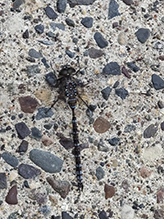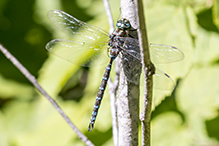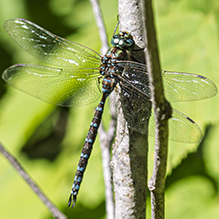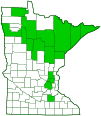lake darner
(Aeshna eremita)
Conservation • Description • Habitat • Ecology • Distribution • Taxonomy
|
|
|||||||||||||
Description |
Lake darner is the largest mosaic darner (genus Aeshna) in North America. Adults are 1 9 ⁄16″ to 3⅛″ long. The female is slightly smaller than the male. It is found throughout Canada, the northern United States, and the Rocky Mountains. In Minnesota it is fairly common in the northern third of the state. It is a late-season dragonfly, flying to the end of September. The body is dark brown with blue or green markings that darken in cool temperatures. Females have three color forms; green, blue, and intermediate. Most females are green form. The thorax of both males and females has two shoulder stripes on the top and a pair of lateral stripes on each side. On males the shoulder stripe is mostly blue, grading to green toward the front. The lateral stripes are parallel and blue grading to green toward the front. On green form females all of the stripes are yellowish-green. On blue form females the stripes are blue grading to green toward the front or all blue. The first (anterior) lateral stripe is deeply notched. The notch is acutely angled, less than 90 °. There is a small dot in the notch. The rear lateral stripe is shallowly notched toward the front. The abdomen is slender with rows of pale spots in a mosaic pattern. On males all 10 abdominal segments have a pair of blue upper (dorsal) spots and blue lateral spots. On green form females all of the spots are yellowish-green. On intermediate form females the dorsal spots are yellowish-green, the lateral spots blue. On newly emerged females all of the markings are blue. On blue form females they remain blue. On the male the pair of appendages at the end of the abdomen (cerci) are paddle-shaped when viewed from above. On females they are large and leaf-like. They do not break off during egg laying. The wings are clear. The wingspan is up to 5⅞″. The forewings are slightly narrower than the hindwings. The forewing and hindwing triangles are equal in size. The face is pale grayish-green. There is a black T-shaped spot on the upper part of the face (frons) below where the eyes meet, and a black horizontal stripe across the middle of the face. The compound eyes are greenish-blue and meet along a long margin at the top of the head. |
Size |
Total length: 1 9 ⁄16″ to 3⅛″ Wingspan: Up to 5⅞″ |
Similar Species |
Canada darner (Aeshna canadensis) is smaller. The posterior thoracic stripe is not notched. |
Habitat |
Bogs, lakes with marshy borders, large ponds, and sometimes slow streams. |
Ecology |
Season |
Mid-June through September |
Behavior |
The adult hunts mostly during the day but also sometimes at dusk. It is a strong flier but does not hover during flight. When hunting it cruises above the water surface with its abdomen slightly arched. It often feeds in swarms, sometimes in great numbers, often with other dragonfly species. It often perches vertically on tree trunks, rarely on the ground. Males are not territorial. |
Life Cycle |
The female deposits eggs one at a time on floating vegetation or inside the stem of emergent vegetation. The larvae (naiads) reach full size in their first year. They overwinter in a state of decreased metabolic activity (diapause). |
Naiad Food |
Insect larvae, freshwater shrimp, tadpoles, and small fish |
Adult Food |
Soft-bodied flying insects |
Distribution |
||
|
Sources Biodiversity occurrence data published by: Minnesota Biodiversity Atlas (accessed through the Minnesota Biodiversity Atlas Portal, bellatlas.umn.edu, 8/2/2025). |
|
| 8/7/2025 | ||
Occurrence |
||
Fairly common |
||
Taxonomy |
|
Order |
Odonata (dragonflies and damselflies) |
Suborder |
|
Superfamily |
Aeshnoidea |
Family |
Aeshnidae (darners) |
Genus |
Aeshna (mosaic darners) |
Subordinate Taxa |
|
|
|
Synonyms |
|
Aeschna eremita Aeschna hudsonica Aeshna hudsonica |
|
Common Names |
|
lake darner |
|
Glossary
Cercus
One of a pair of small sensory appendages at the end of the abdomen of many insects and other arthropods. In Odonata, one of the upper claspers. Plural: cerci.
Diapause
A period of decreased metabolic activity and suspended development.
Frons
The upper front part of an insect’s face, roughly corresponding to the forehead.
Naiad
The aquatic larval form (nymph) of a dragonfly, mayfly, or stonefly.
Visitor Photos |
||
Share your photo of this insect. |
||
This button not working for you? |
||
Jeremy L |
 |
Darner with Mosaic Body on Mosaic Rocks |
MinnesotaSeasons.com Photos |
||
 |
 |

Slideshows |
|

Visitor Videos |
||
Share your video of this insect. |
||
This button not working for you? |
||
|
Other Videos |
||
Finding Uncommon Dragonfly Species |
About
Published on Nov 8, 2013 Mud Lake is a subalpine fen near Skalkaho Pass, Montana. Fens are infrequent, as such the community of species using this habitat are uncommon to rare. I have visited this site several times looking for two particular dragonfly species found here: Lake Darner (Aeshna eremita) and Subarctic Darner (Aeshna subarctica). This video captures the adventure and my happiness in finally finding and photographing them on September 9, 2013. |
Mosaic Darner, Hawker Dragonfly (Aeshna genus) |
About
Published on Feb 10, 2014 A Mosaic Darner from the Aeshna genus near Creston, BC. It's most likely a Lake Darner (Aeshna eremita), Variable Darner (Aeshna interrupta), or a Canada Darner (Aeshna canadensis). Aeshnidae family, Aeshna genus, Canada dragonfly, Canadian dragonfly, Anisoptera |

Created: 2/28/2016 Last Updated: © MinnesotaSeasons.com. All rights reserved. |


